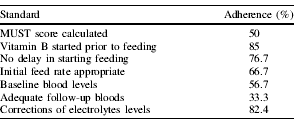Refeeding syndrome results from severe fluid and electrolyte shifts in malnourished patients, and is associated with the initiation of nutritional support.(Reference Solomon and Kirkby1) NICE has categorised risk as: moderate, high and severely high.(2, Reference Tomlin3) High risk patients are recommended an initial feed rate of 10 kcal/kg/day. A recent enquiry into the care of hospital patients receiving parenteral nutrition, found only a low number had their nutritional requirements documented.(Reference Stewart, Mason, Smith, Protopapa and Mason4)
This audit aimed to determine the current practice in the prevention and treatment of refeeding syndrome in this Trust. Also the adherence to NICE guidelines and the use of the Malnutrition Universal Screening Tool (MUST).
The audit took place over 11 weeks. Patients initiated on artificial feeding were identified by either a dietitian or the nutrition team. The patients were assessed for inclusion criteria (over 18 years, started on artificial nutrition whilst an inpatient) and exclusion criteria (end-of-life treatment, supplementary artificial nutrition, artificial nutrition initiated whilst in the critical care complex). Data were collected for 7 days using the drug chart, observation chart, medical notes, dietetic chart and blood levels. A pilot study was conducted on one patient to assess the appropriateness of the data collection form.
37 patients were identified, 30 of these were found to be suitable. Of the 30 patients, 19 (63.3%) were male (median age; 77.5, range; 31–94). 19 patients (63.3%) were receiving artificial nutrition due to an unsafe swallow, 6 (20%) had undergone gastrointestinal surgery and 5 (16.7%) were previously receiving inadequate oral intake. 16 (53.3%) patients were documented as at risk of refeeding syndrome. 25 patients (83.3%) had their nutrition managed by a dietitian, 11 (36.7%) by the nutrition team and 1 (3.3%) by their doctor, 8 (26.7%) patients were managed by more than one healthcare professional. 20 patients (66.7%) received nasogastric feeding, 4 (13.3%) gastrostomy feeding, 1 nasojejual feeding and 5 (16.7%) parenteral nutrition. Adherence to audit standards was obtained from the audit tool.

This small audit recognizes identified areas of the management of refeeding syndrome that need further consideration. It would be useful to undertake this audit on a larger scale to substantiate these findings.


